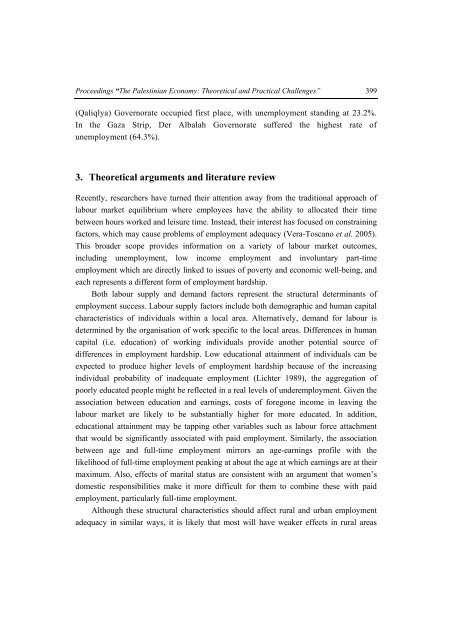The Palestinian Economy. Theoretical and Practical Challenges
The Palestinian Economy. Theoretical and Practical Challenges
The Palestinian Economy. Theoretical and Practical Challenges
Create successful ePaper yourself
Turn your PDF publications into a flip-book with our unique Google optimized e-Paper software.
Proceedings “<strong>The</strong> <strong>Palestinian</strong> <strong>Economy</strong>: <strong>The</strong>oretical <strong>and</strong> <strong>Practical</strong> <strong>Challenges</strong>” 399<br />
(Qaliqlya) Governorate occupied first place, with unemployment st<strong>and</strong>ing at 23.2%.<br />
In the Gaza Strip, Der Albalah Governorate suffered the highest rate of<br />
unemployment (64.3%).<br />
3. <strong>The</strong>oretical arguments <strong>and</strong> literature review<br />
Recently, researchers have turned their attention away from the traditional approach of<br />
labour market equilibrium where employees have the ability to allocated their time<br />
between hours worked <strong>and</strong> leisure time. Instead, their interest has focused on constraining<br />
factors, which may cause problems of employment adequacy (Vera-Toscano et al. 2005).<br />
This broader scope provides information on a variety of labour market outcomes,<br />
including unemployment, low income employment <strong>and</strong> involuntary part-time<br />
employment which are directly linked to issues of poverty <strong>and</strong> economic well-being, <strong>and</strong><br />
each represents a different form of employment hardship.<br />
Both labour supply <strong>and</strong> dem<strong>and</strong> factors represent the structural determinants of<br />
employment success. Labour supply factors include both demographic <strong>and</strong> human capital<br />
characteristics of individuals within a local area. Alternatively, dem<strong>and</strong> for labour is<br />
determined by the organisation of work specific to the local areas. Differences in human<br />
capital (i.e. education) of working individuals provide another potential source of<br />
differences in employment hardship. Low educational attainment of individuals can be<br />
expected to produce higher levels of employment hardship because of the increasing<br />
individual probability of inadequate employment (Lichter 1989), the aggregation of<br />
poorly educated people might be reflected in a real levels of underemployment. Given the<br />
association between education <strong>and</strong> earnings, costs of foregone income in leaving the<br />
labour market are likely to be substantially higher for more educated. In addition,<br />
educational attainment may be tapping other variables such as labour force attachment<br />
that would be significantly associated with paid employment. Similarly, the association<br />
between age <strong>and</strong> full-time employment mirrors an age-earnings profile with the<br />
likelihood of full-time employment peaking at about the age at which earnings are at their<br />
maximum. Also, effects of marital status are consistent with an argument that women’s<br />
domestic responsibilities make it more difficult for them to combine these with paid<br />
employment, particularly full-time employment.<br />
Although these structural characteristics should affect rural <strong>and</strong> urban employment<br />
adequacy in similar ways, it is likely that most will have weaker effects in rural areas
















